By Yong Yang
At the OpenAnolis sub-forum of the 2022 OpenAtom Global Open Source Summit, Yong Yang (Chairman of the OpenAnolis Technical Committee) gave a keynote speech on the OpenAnolis Technology Development Report. He shared the experience of how OpenAnolis realized the layout of the native community from scratch and developed the cloud-based open-source industry innovation ecology.
The following is the full speech:
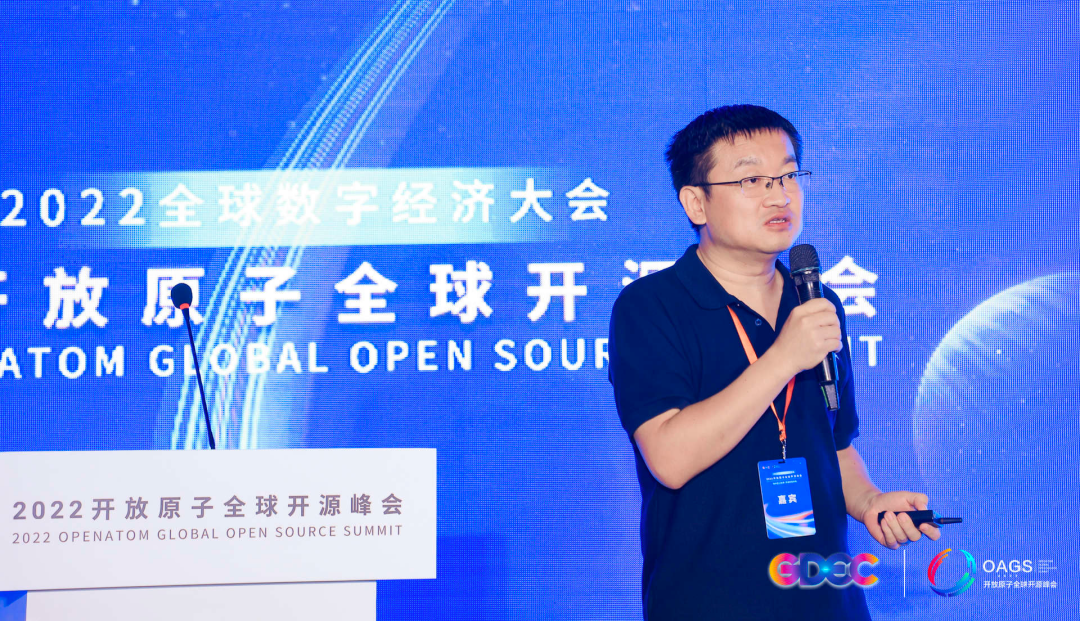
(Picture: Yong Yang, Chairman of the OpenAnolis Technical Committee)
In May 2021, OpenAnolis released the first Linux distribution, Anolis OS 8.2. Through continuous iteration of products to meet the needs of community users, it officially started to embrace the open-source operating system. So far, OpenAnolis has completed a lot of product iteration and community operation work. It focuses on user needs to solve the problem of CentOS EOL by adopting new release versions and technology roadmaps. Based on the community platform, all industries and cooperation units work together, which initially formed the product matrix. Due to the strong demand for CentOS substitution and user cloudification, in just one year, there are 130 million installments, 1 million downloads, 40 + SIG groups, and 120 + maintainers. All kinds of data show that OpenAnolis has achieved a leap-forward development from making products to making communities. It completed the layout of the native community, ushering in explosive growth**.
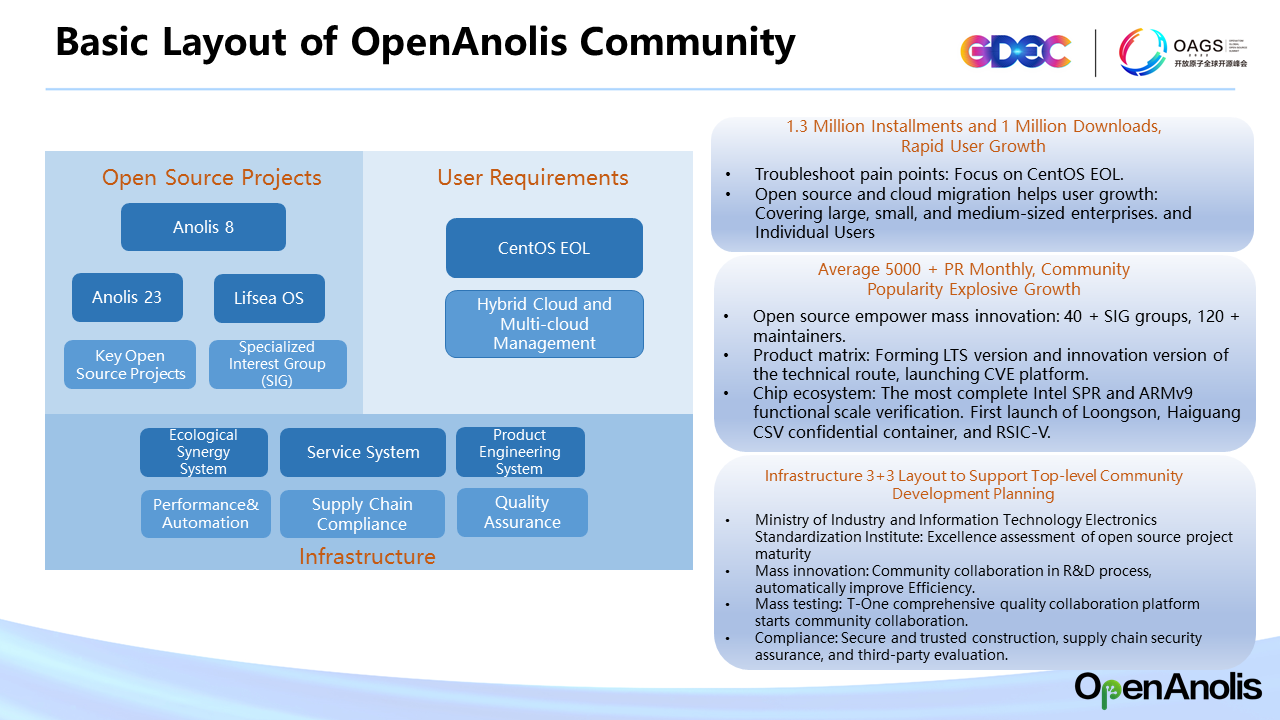
Currently, the entire infrastructure is a 3+3 layout, supporting the sustainable development plan of the community.
OpenAnolis now has a monthly average of 5000 + PR because of the 3+3 system, maintaining continuous popularity and becoming an active open-source community in China. It is worth mentioning that OpenAnolis has established a distinctive chip ecosystem, which supports domestic and international mainstream chips with the fastest speed and the most comprehensive types. For example, the community supports the most complete Intel SPR in China and verifies the most diversified function scale of ARMv9. It supports LoongArch and Hygon CSV confidential containers with the industry-first support, and the first release of RSIC-V new features in Anolis OS 8.6.
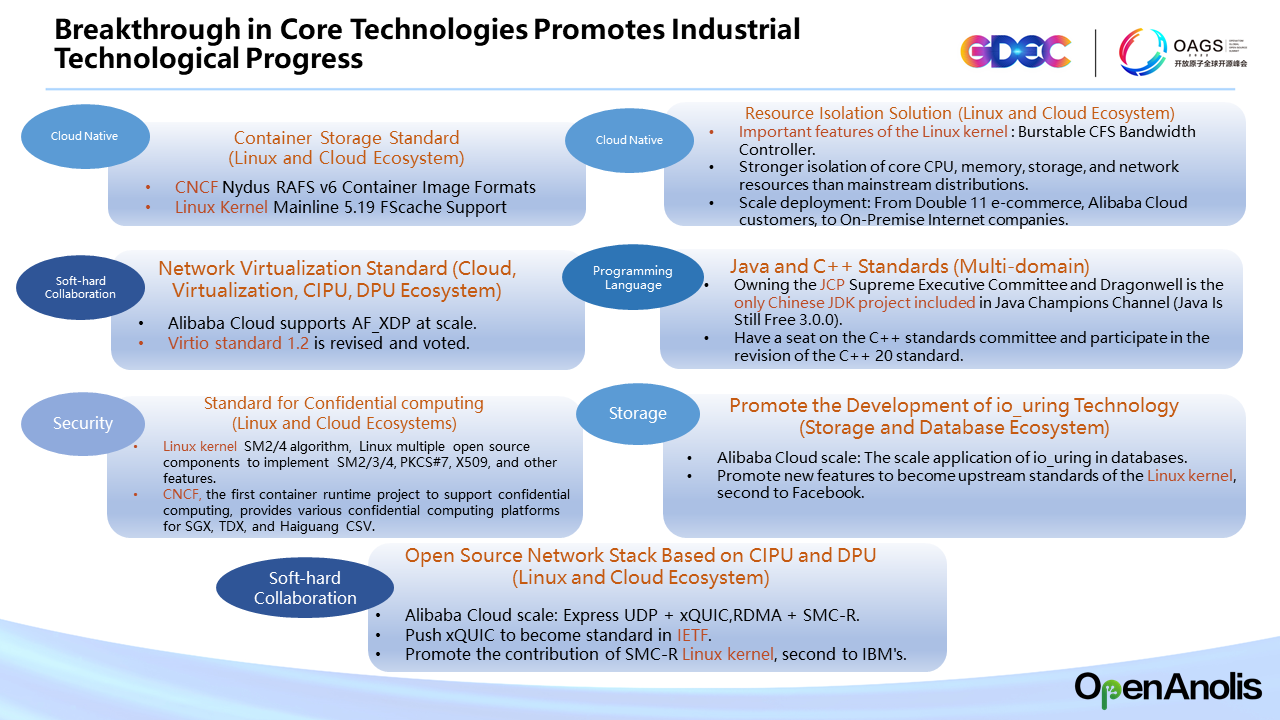
OpenAnolis has six technical directions: One cloud with multiple chip architectures support, cloud-native, Hardware-software co-design, programming language, security, and high performance. In each direction, it can be developed in the international community with international standards. For example, in terms of container storage, OpenAnolis supports a new read-only storage standard called NydusRAFS v6 through the Linux project in the CNCF community and integrates FScache in the Linux upstream kernel mainline 5.19. We have established the storage image distribution standard of containers through these two projects. We believe the entire cloud native ecology in this area in China will be influenced by the technology of OpenAnolis in several years. In this process, we have also received support from many Internet companies that helped directly in the upstream community of Linux. We have seen the power of community mass innovation and mass testing from this situation.
Another good example is in terms of sofware and hardware co-design. We have supported a new virtio specification on the Alibaba Cloud OpenAnolis product line. Through this specification, we have passed AF_XDP (the standard protocol of Linux) in DPU scenarios, which wouldn't work in the past. We put our features into standard 1.2 by proposing amendments to the virtio virtualization network interface standard. As a result, we see some international DPU manufacturers discussing 1.2 standard support in the Linux community. We can see the influence of OpenAnolis through this example. Once the new virtio standard is adopted, it will have an impact on virtualization and the DPU industry.
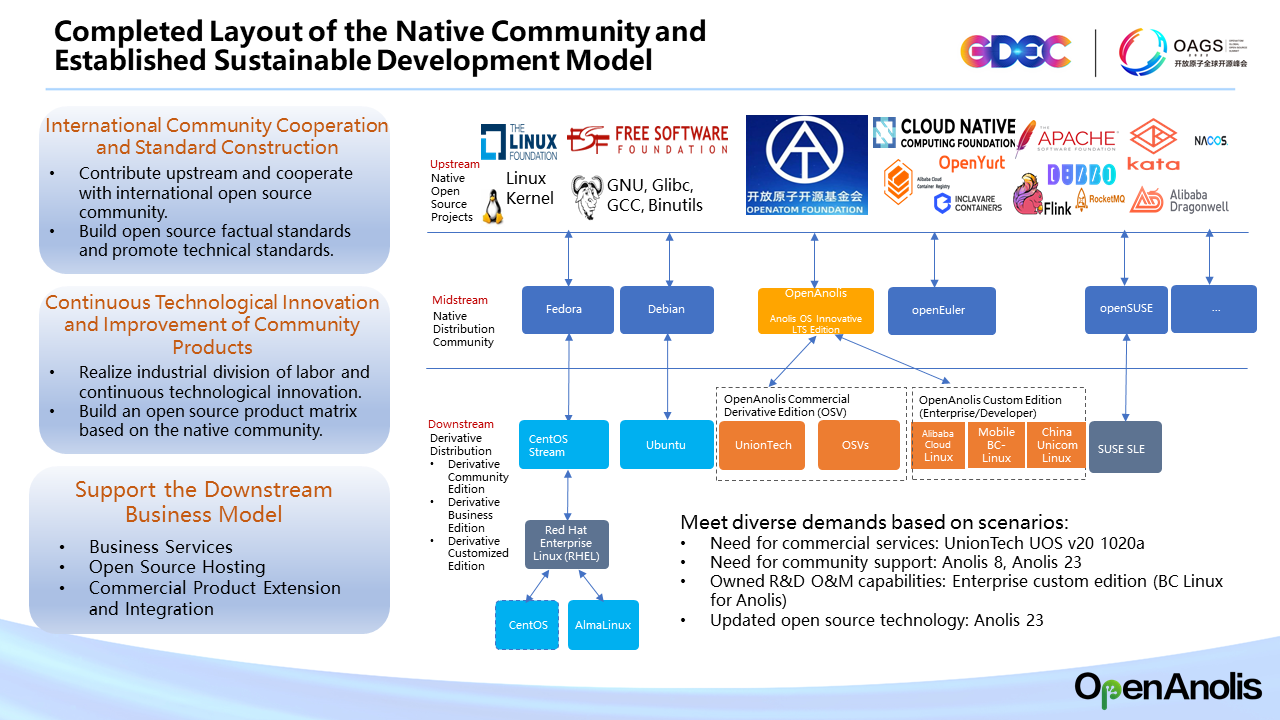
There are so many opinions on how to evaluate the competitiveness of open-source operating systems that there is no standard answer. How can technology leadership be reflected in open-source operating systems? The answer lies in whether we can carry out upstream innovation in the international community and influence the industry through our open-source factual standards. OpenAnolis is in the midstream distribution layer. Is the competitiveness of the operating system reflected in this layer? No, we know that if OpenAnolis is the same as Debian and Fedora today, we cannot stop here. Therefore, the capabilities to be achieved by this community are the upstream and downstream layers in the figure. Each layer must have a mission and goals, including international community cooperation to build standards, continuous technological innovation, improvement of community products, and downstream business model support. These are the native community capabilities that we believe a leading open-source operating system should build. OpenAnolis has a better sustainable development model through the collaboration of the upstream and downstream layers.
OpenAnolis has formed a complete layout by building Anolis OS 8 and Anolis OS 23. Anolis OS 23 can quickly absorb and promote upstream innovation. The LTS version can empower the industry with various business models. This is a good foundation and starting point.
The operating system industry is closely related to the computing industry. We believe the future of the two must be related. Therefore, we must consider the changes in the computing industry during the technical planning of the operating system. We have seen the rapid development of China's cloud computing industry over the past ten years. Cloud manufacturers are investing in Linux operating systems (including AWS and Microsoft), chip customization, complete machine redesign, software and hardware combination considerations, DPU, etc. At the same time, we have seen a relatively rapid evolution of programming languages and programming patterns in the cloud computing model.
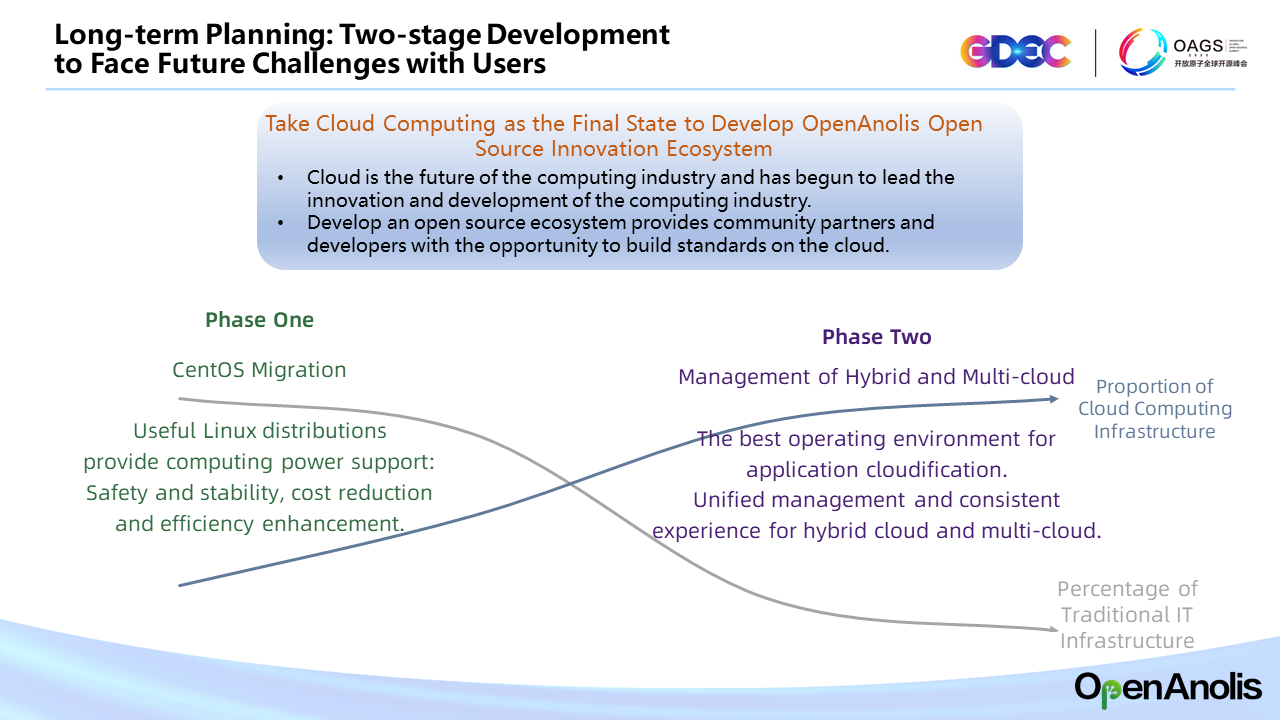
We believe that the entire technical planning of today's operating system should be considered for the future. First of all, OpenAnolis provides users with a useful and available Linux distribution to support the current computing power. It should also consider how future users manage the data center and how to do a good job in integrated management driven by the development of cloud computing. Today's users have unified multi-cloud management in virtual machines, bare metals, and physical machines, including programming languages and cloud-native programming modes. These are all topics the operating system community should consider. OpenAnolis will take cloud computing as its final state, develop an open-source innovation ecosystem, provide community partners and developers with the opportunity to build standards on the cloud, and face future challenges together with users.
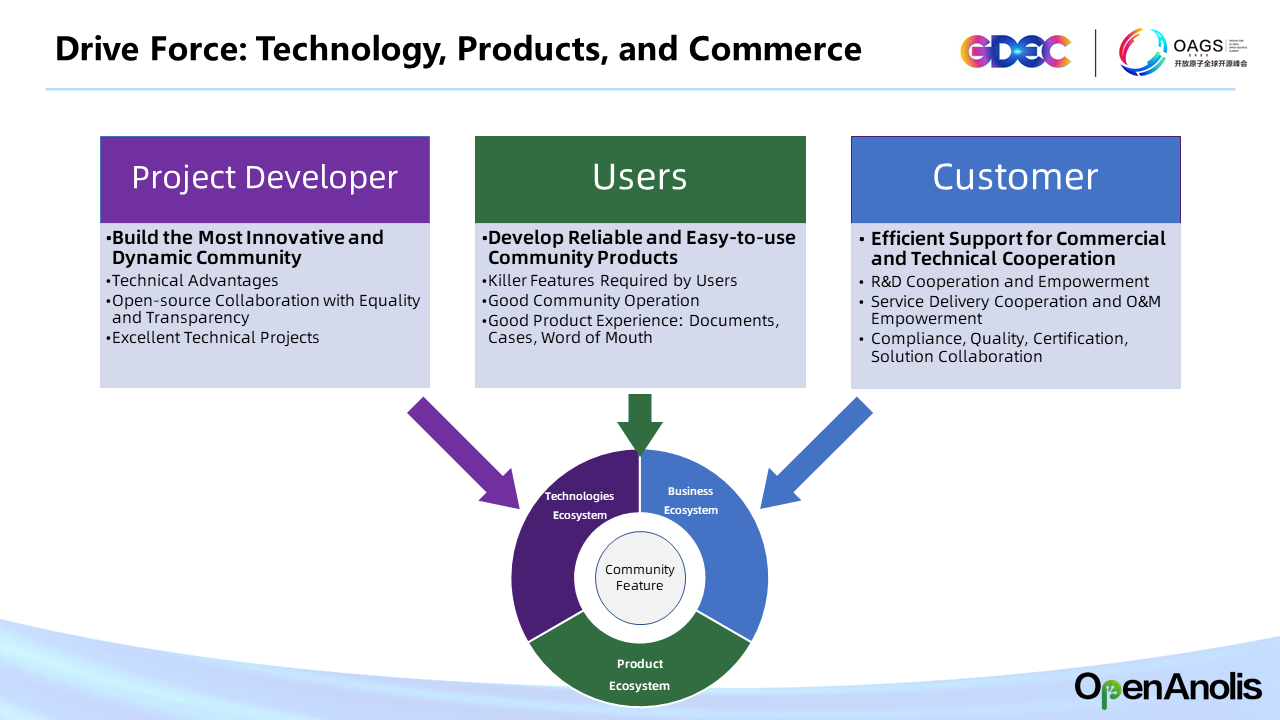
How do we measure the progress of an open-source technology community? The progress of the open-source technology community is difficult to be driven by KPIs like managing a company. We think the best measure is whether the things are done right at the moment and whether or not it is in positive feedback. In the new year's plan, OpenAnolis will think from three aspects: developers, users, and customers. As the operating system is an existing mature product category, the primary task of OpenAnolis over the past year is to deepen the products, meet the needs of customers and users, build community value, enlarge the value of developers, and strive to build a community with great innovation and vitality.
I'd like to share a story with you. Recently, I got positive feedback from someone in an IM group about opensource technology. Then, I added him to communicate further and found out he was an active developer in the exchange group of OpenAnolis and a seed user with product requirements. Therefore, I think we can support customer-side business and technical cooperation by developing reliable and easy-to-use community products, letting users become our product managers, and exploring the community development direction from user needs. Technology ecology, product ecology, and business ecology are the drivers of OpenAnolis, bringing more competitiveness to the brand and the community.
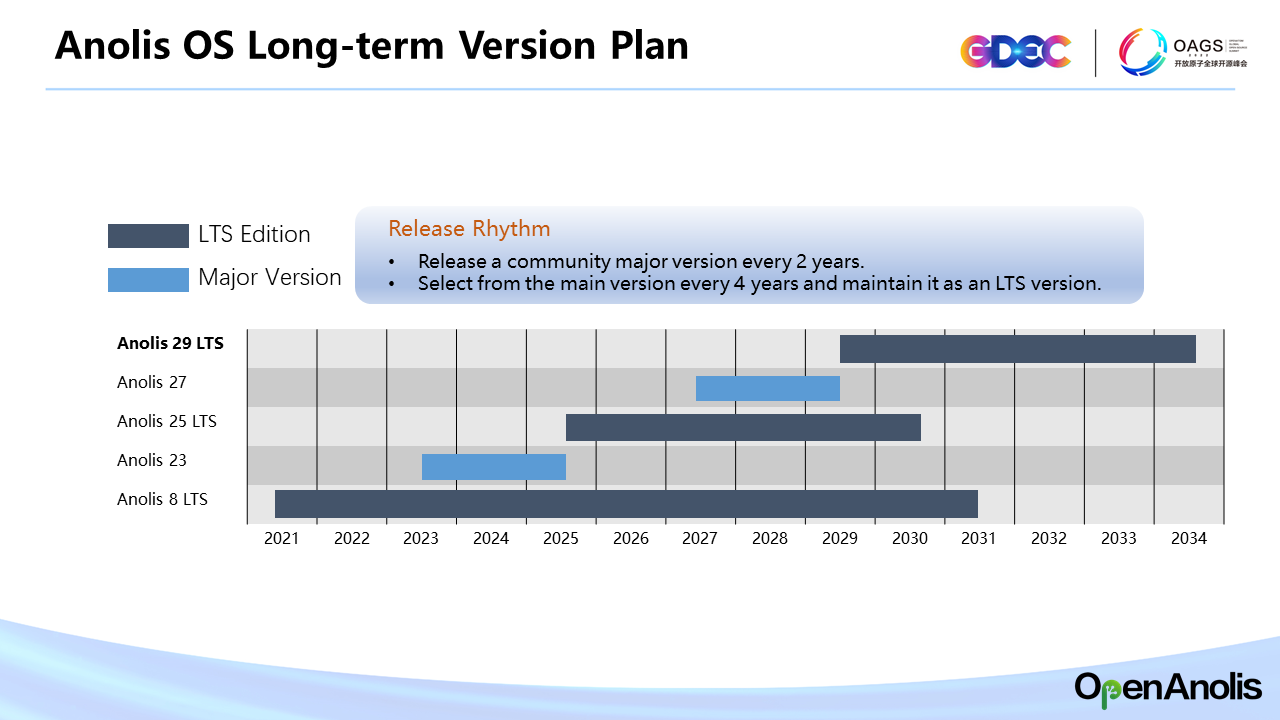
In the future, OpenAnolis will implement a new focus on the product matrix. Currently, the main focus of the community is Anolis OS, which is a classic Linux distribution of the operating system. It integrates cloud innovative technologies, community software and hardware co-design ecology, commercial operating systems, etc. The roadmap of Anolis OS supports the overall development plan of the community and has a significant position. Therefore, we promise to release a community Anolis OS major version every two years and select an LTS version from the major version released every four years for long-term stable support. Anolis OS 23 is the next version of Anolis OS 8 and Anolis OS 25 is an LTS. The development stage of OpenAnolis and the products are shown in the figure above. Today, the running version of the Anolis OS 23 has been released in OpenAnolis. You are welcome to download and try it out (please see the end of the article for the download link).
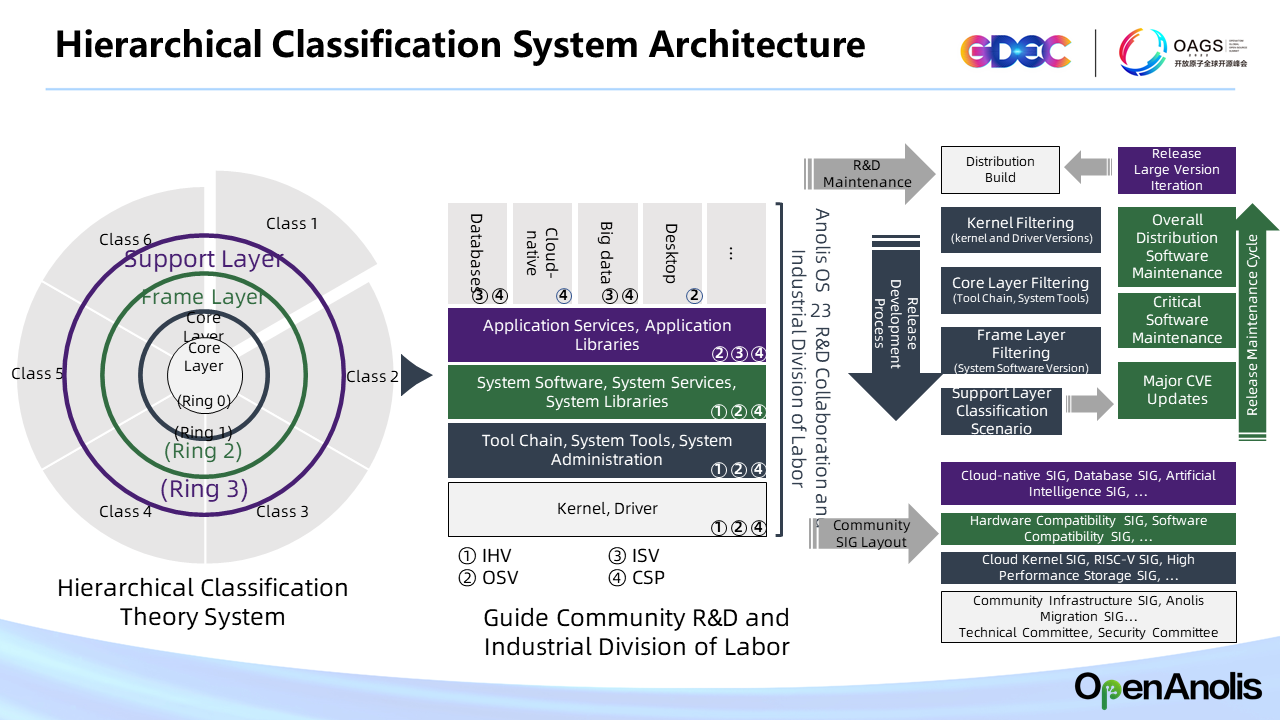
Looking at the product development roadmap of Anolis OS, there is a top-level design thinking behind it, which is called hierarchical classification system architecture. The selection of Anolis OS 8 is guided by the hierarchical classification system architecture. Although the Linux open-source operating system is the so-called Bazaar development, a well-functioned technical architecture and the cooperation of industrial division of labor are reflected in it from the perspective of the division of labor between commercial products and community research and development, according to the hierarchical classification theory system. Due to the different industrial divisions of labor and technical competitiveness, different manufacturers will have different technical layouts. LoongArch's 2+3+3+2 focuses on technology. The two 3s in the middle are application-oriented high-level programming languages and hardware-oriented optimization languages. The technical layouts of different chip manufacturers here are different. A chip manufacturer will distinguish different investment priorities in several languages and kernel areas and decide whether the original factory or the ecological partner will do the definition and who will do the kernel. All in all, no matter whether they are cloud manufacturers, chip manufacturers, hardware manufacturers, or operating system manufacturers, they will have overlapping parts in the operating system research and development investment. However, the research and development focus is complementary. This is the basis of the rich ecology of OpenAnolis. Based on the hierarchical classification system architecture, the follow-up overall research and development of OpenAnolis will bring in more industrial partners and clarify the cooperation mode.
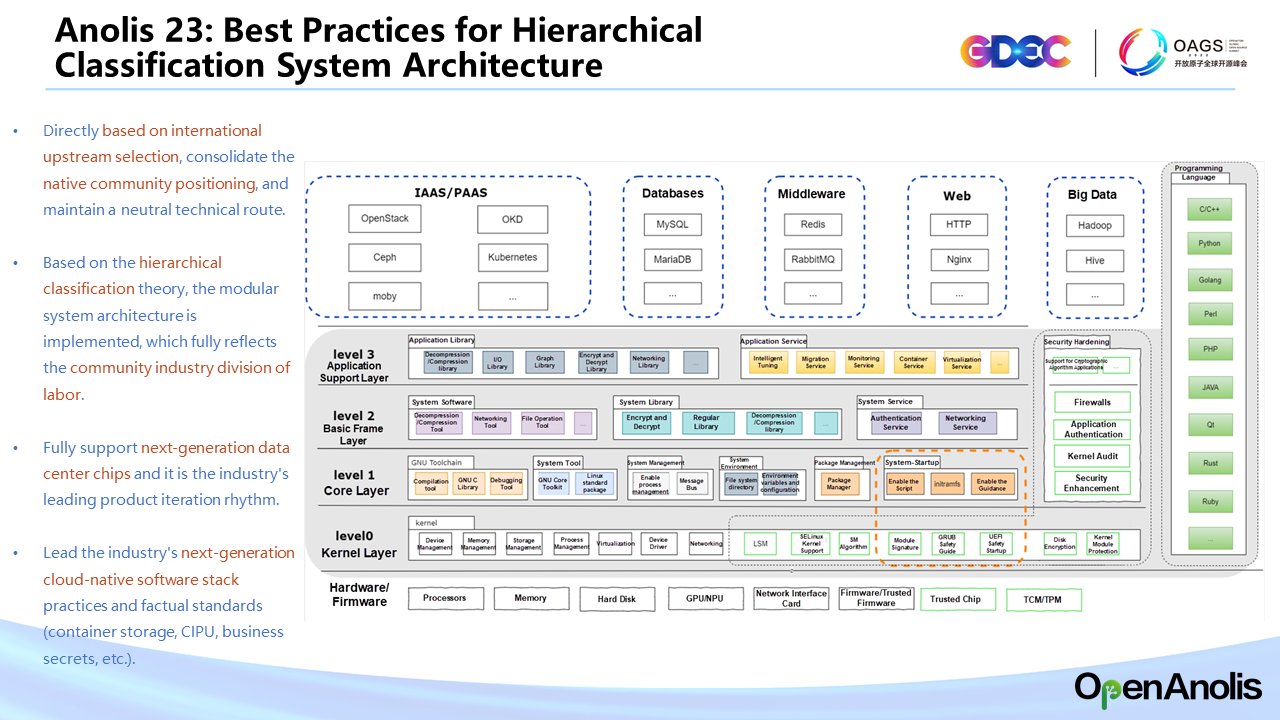
Anolis OS 23 is the best practice of hierarchical classification system architecture. The selection of operating systems can be a heated topic and require much engineering. From the construction of the overall system, the research and development of original technologies, and the creation of industry standards, the overall project is undertaken through SIG, forming a relatively complete layout. As far as Anolis OS 23 is concerned, I think there are four major points:
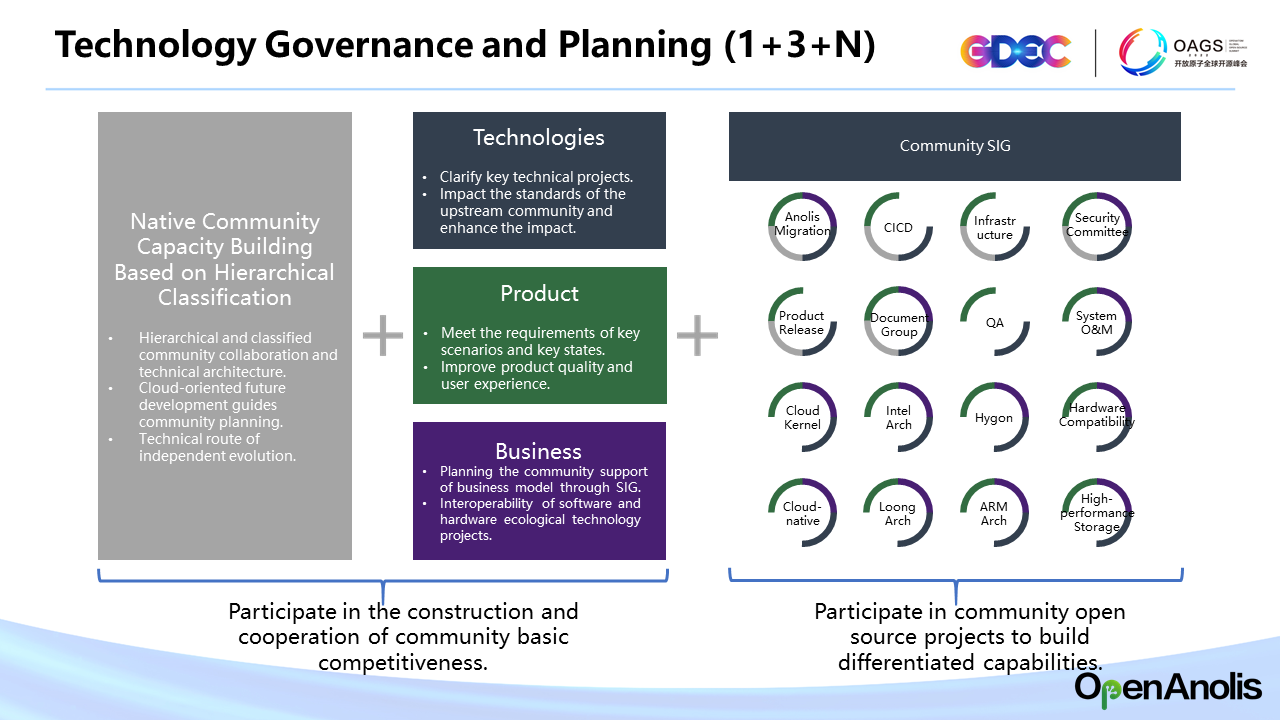
Based On the preceding theories and practices, we proposed a 1+3 + N" development direction from the perspective of the entire community technology planning and operation. Among them, 1 refers to native community capacity building based on hierarchical classification, which is the most important foundation. Based on the hierarchical and classified community collaboration and technical architecture, the cloud-oriented future development guides community planning and creates a technical roadmap for independent and independent evolution. 3 refers to technology, product, and business. The community technical committee will support these three aspects of work. N is the SIG matrix of OpenAnolis, which is the most landing part. SIG is landed based on the goal of technology, products, and business and creates competitive differentiation capabilities. The colors of the SIG in the figure above represent the native capabilities of the corresponding communities in technology, products, and commerce.
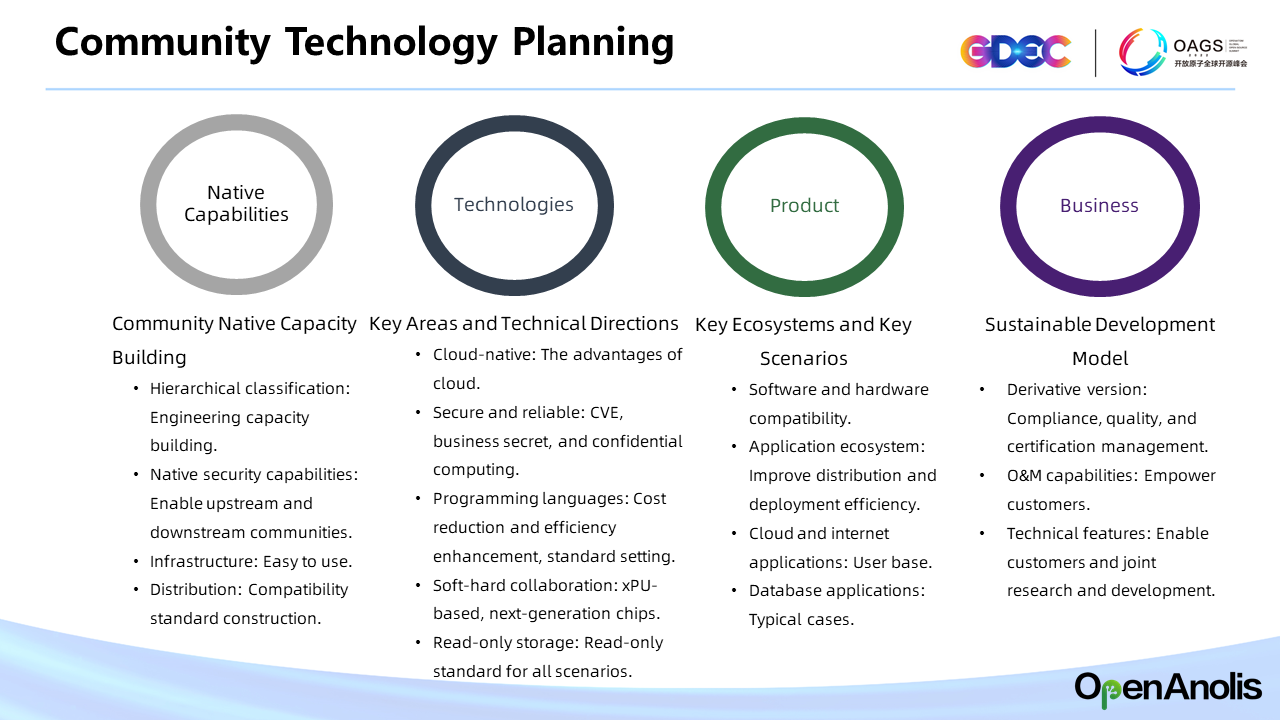
Finally, I would like to share the overall technical plan of OpenAnolis:
Anolis OS 23 poC version download address: https://openanolis.cn/download
Open-Source SysOM of Anolis: A Comprehensive O&M Management Platform

85 posts | 5 followers
FollowOpenAnolis - December 8, 2022
OpenAnolis - July 8, 2022
OpenAnolis - December 7, 2022
Alibaba Cloud Community - September 5, 2022
OpenAnolis - July 8, 2022
OpenAnolis - December 12, 2023

85 posts | 5 followers
Follow Alibaba Cloud Linux
Alibaba Cloud Linux
Alibaba Cloud Linux is a free-to-use, native operating system that provides a stable, reliable, and high-performance environment for your applications.
Learn More Retail Solution
Retail Solution
Alibaba Cloud enables digital retail transformation to fuel growth and realize an omnichannel customer experience throughout the consumer journey.
Learn More Big Data Consulting for Data Technology Solution
Big Data Consulting for Data Technology Solution
Alibaba Cloud provides big data consulting services to help enterprises leverage advanced data technology.
Learn More Digital Marketing Solution
Digital Marketing Solution
Transform your business into a customer-centric brand while keeping marketing campaigns cost effective.
Learn MoreMore Posts by OpenAnolis